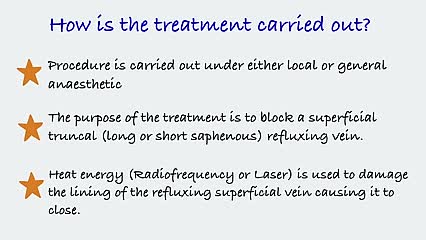Endo-Venous Mechano-Chemical Ablation (MOCA)
Introduction
What is it?
MOCA is a newer technique used in the treatment of venous insufficiency. It is a minimally-invasive, non-thermal procedure that uses both a chemical or ‘sclerosant’ such as sodium tetradecyl sulphate, as well using a special probe to irreversibly close the vein. Once the sclerosant comes in contact with the vein it causes a reaction, whilst the rotating probe will strip the inner lining of the vein. This will reduce the visibility of the vein at the skin surface. Not all centres may offer MOCA as a treatment option.
Will I need to do any preparation?
MOCA is often undertaken under the local anaesthetic, however you should confirm this with your surgeon. If this is the case, you will not have to fast before the procedure. You should check with your surgeon if there are any medications (such as anticoagulation) you should stop beforehand. Many centres ask that you have not had a long-haul (over 4 hours) flight in the 2 weeks before the procedure
Technique
What does it involve?
You will be asked to lie down on an operating table or couch in the best position to access the vein being treated. If the target vein is located in the back of the calf, you will likely be asked to lie on your front otherwise on your back.
During the procedure, the surgeon will ask for the bed to be tilted with your head-up or down. This will either be to fill the vein, so it is easier to target, or empty to improve the effect of treatment.
Modern varicose vein treatments are often undertaken as day case procedures. This often leads to a quicker recovery time following the treatment and means you do not have to fast beforehand. In some circumstances it may be appropriate to undertake the procedure under general anaesthetic, and it is worth clarifying this with the surgeon in your consultation.
Before starting MOCA, an ultrasound machine will be used to scan the veins. The leg will then be prepared with antiseptic solution and sterile drapes are applied to cover the areas which have not be cleaned.
The procedure can be broken down into a number of steps: 1. Access to the vein being treated; 2. Positioning of the MOCA device; 4. Ablation. Each one will be described in turn.
1. Access to the vein being treated.
Ultrasound is used to visualise the exact location of the vein being treated. Once the target vein has been identified they will inject local anaesthetic and use a small needle to access the vein. The needle should be guided by the ultrasound scan to make it as easy as possible. Once the needle is in the vein, a metal wire is passed through the needle into the vein. The needle is then removed and replaced by a narrow flexible plastic pipe called a catheter. In order to fit the catheter into the vein easily, a scalpel may be used to nick the skin.
2. Positioning of the MOCA device.
The catheter probe will be placed in the region that requires treating, but away from the main or deep veins.

4. Ablation
The catheter probe will slowly be removed as the probe begins to simultaneous inject sclerosant and mechanically disrupt the vein. Once the desired length is treated the instruments will be removed from your leg.
MOCA is best used in straighter veins. If discussed prior to the operation, you may choose to do an additional procedure (see phlebectomies or foam sclerotherapy) to treat feeding (tributory) veins.
Post procedure course (follow-up)
The care after MOCA will depend on individual practices and needs. Typically, you will have a full-length bandage which is worn for 1-2 days. You may be given antibiotic tablets, especially if you have an ulcer, or an injection of an anticoagulant to reduce the risk of deep vein thrombosis (DVT).
In the days after the procedure you should aim to regularly mobilise. You may also be asked to wear a compression stocking to reduce the risk of DVT. In some circumstances, for example if you have a high risk of DVT, you may be asked to take an anticoagulant tablet or injection following the procedure. Always check the discharge paperwork for detailed post procedure instructions.
The average time to return to usual daily activities is approximately 3.5 days (1).
How long will I stay in hospital?
MOCA is often undertaken as a day case procedure using local anaesthetic. You will therefore be able to go home the same day after the procedure.




